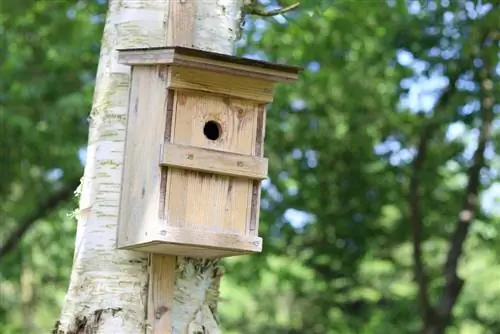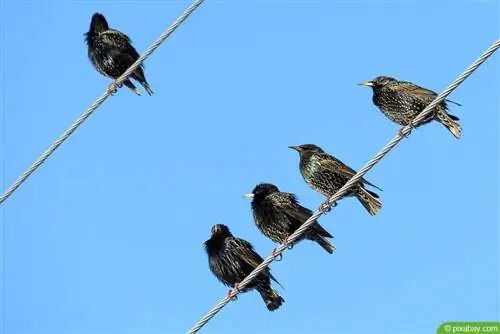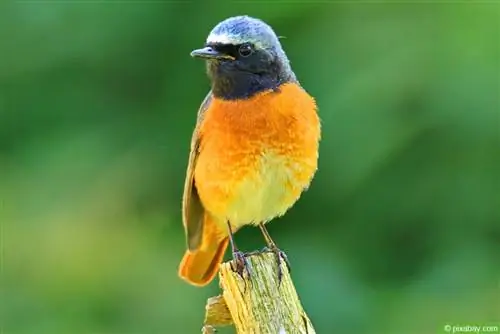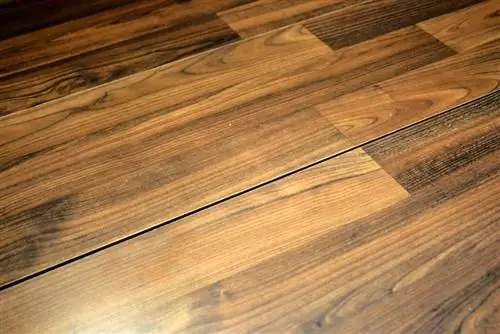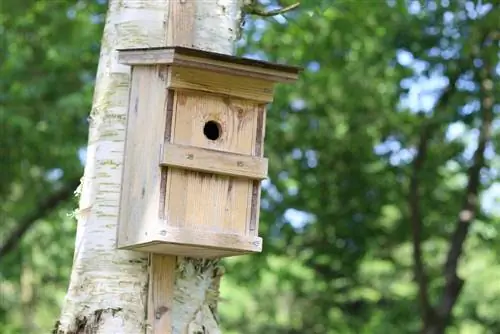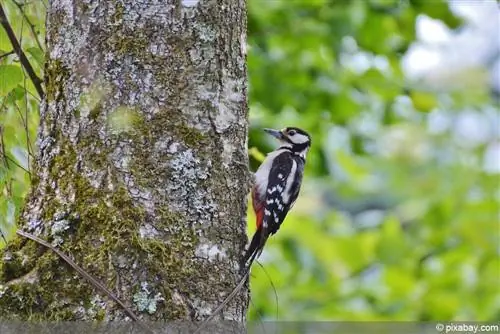- Author admin [email protected].
- Public 2023-12-17 03:39.
- Last modified 2025-06-01 06:48.
No matter whether tits, robins or starlings - in order to lay eggs, brood and raise their young, birds need a safe nesting place. In our modern cultural landscape, however, these are becoming increasingly rare. Nesting boxes made and hung by humans are therefore of great importance for the survival of the animals. However, in order for this to work, a few points must be taken into account when hanging.
Nestbox
A nesting box is an artificially created structure that provides birds with a secure cavity in which they can build a nest and raise their offspring. However, not all nesting boxes are the same.
That means: Not every shape is suitable for every type of bird. However, with a shape that follows the classic starling box, a safe breeding space can be built for most of the bird species that occur here. The size and, above all, the diameter of the entry hole is of course important and should not be underestimated. After all, the animals have to have enough space for a nest and be able to get into the box in the first place.
The rule of thumb is: the larger the bird species, the larger the nesting box and entry hole must be.
Tip:
Before you start building or buying a nesting box, it's best to observe which bird species are common in the garden and only then make a decision.
Location
The ideal location for a nesting box must meet two main requirements: It should definitely offer security from predators and be protected from the adverse weather conditions. The most dangerous predators for birds are cats and martens. Cats in particular kill hundreds of thousands of birds every year. It is therefore crucial to place a nesting box out of the reach of these animals.
The problem is that cats are excellent climbers and can easily climb a tree. Nevertheless, a nesting box that hangs at a height of two to five meters is usually sufficiently protected from access by a cat. The situation is very similar with martens. Basically, the following objects are suitable for attaching nesting boxes to:
- Trees
- free-standing poles and masts
- Exterior walls of houses, garages and sheds
- Roof projections
In addition to protection from predators, weather protection also plays a major role when choosing a location. Under no circumstances should it be possible for rain to enter the box through the entrance hole. It should also be protected from strong winds.
Direction
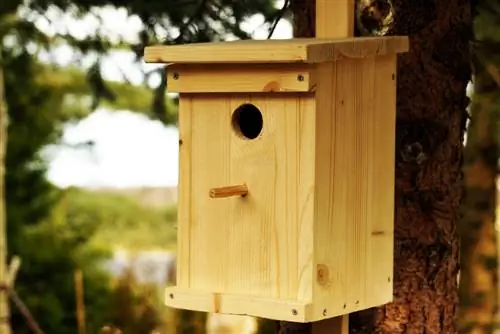
The central aspect in reliably protecting a nesting or starling box from the vagaries of the weather is the direction in which it is aligned. If possible, it should definitely be installed in a place protected from the wind - so that the entrance opening faces north, northeast or east. Under no circumstances should it face south, as this can lead to strong heating inside the box by the sun. The direction of the compass or the orientation of the entry hole applies to all bird species, from titmice to robins to starlings.
Time
It's best to hang a new nesting box in the fall or late fall of the previous year. Although no bird will use it at this point, it will get rid of any smells that could irritate the animals by spring. Nesting boxes should definitely be in place by February at the latest.
Hanging
Basically there are two methods for hanging up nesting boxes safely. On the one hand, there is the classic hanging, in which the box is hung on a nail, a hook or simply a branch.
Tip:
If you want to hang a nesting box on a tree using a nail, you should definitely use an aluminum nail. This can prevent serious damage to the tree.
The second method of hanging nest boxes is based on hinges or loops. Hinges are often used when the box is to be attached to a wall. Wire loops, on the other hand, are perfect for mounting on trees and other round objects. For trees, however, the loop should be covered to prevent the wire from cutting into the sensitive bark and thus damaging the tree. An old garden hose, for example, can serve as a casing. It is also important to really tighten the sling(s) to ensure that the nesting box stays in place and does not slip off.
Distance
If you want to hang several nesting boxes at the same time, it's a good idea to keep enough distance between them. Even though birds seem to us to be very peace-loving creatures, there are sometimes conflicts among them. Especially when the animals are breeding, they sometimes react hostilely towards members of their own species and, above all, other bird species. They defend their territory, the center of which is the nest. The distance between two nesting boxes should therefore be at least three meters. However, a distance of ten meters is better.
Cleaning
Birds can easily build a nest in a nesting box. However, you can no longer remove the nest after the young have fledged. But that is exactly what is necessary to clear the box of feces and food residues. After ensuring that it is no longer being used, a nesting or starling box must be completely cleared out and cleaned. Cleaning is done exclusively with warm water and a brush. Cleaning agents should not be used. Without this cleaning, there is a risk that germs will form. On the other hand, it may also be that the animals simply do not want to accept a dirty box next year.

